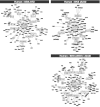Identification of cross-species shared transcriptional networks of diabetic nephropathy in human and mouse glomeruli
- PMID: 23139354
- PMCID: PMC3526018
- DOI: 10.2337/db11-1667
Identification of cross-species shared transcriptional networks of diabetic nephropathy in human and mouse glomeruli
Abstract
Murine models are valuable instruments in defining the pathogenesis of diabetic nephropathy (DN), but they only partially recapitulate disease manifestations of human DN, limiting their utility. To define the molecular similarities and differences between human and murine DN, we performed a cross-species comparison of glomerular transcriptional networks. Glomerular gene expression was profiled in patients with early type 2 DN and in three mouse models (streptozotocin DBA/2, C57BLKS db/db, and eNOS-deficient C57BLKS db/db mice). Species-specific transcriptional networks were generated and compared with a novel network-matching algorithm. Three shared human-mouse cross-species glomerular transcriptional networks containing 143 (Human-DBA STZ), 97 (Human-BKS db/db), and 162 (Human-BKS eNOS(-/-) db/db) gene nodes were generated. Shared nodes across all networks reflected established pathogenic mechanisms of diabetes complications, such as elements of Janus kinase (JAK)/signal transducer and activator of transcription (STAT) and vascular endothelial growth factor receptor (VEGFR) signaling pathways. In addition, novel pathways not previously associated with DN and cross-species gene nodes and pathways unique to each of the human-mouse networks were discovered. The human-mouse shared glomerular transcriptional networks will assist DN researchers in selecting mouse models most relevant to the human disease process of interest. Moreover, they will allow identification of new pathways shared between mice and humans.
Figures




Comment in
-
A transcriptional blueprint for human and murine diabetic kidney disease.Diabetes. 2013 Jan;62(1):31-3. doi: 10.2337/db12-1121. Diabetes. 2013. PMID: 23258910 Free PMC article. No abstract available.
References
-
- U.S. Renal Data System USRDS 2010 Annual Data Report: Atlas of Chronic Kidney Disease and End-Stage Renal Disease in the United States. Bethesda, MD, National Institutes of Health, National Institute of Diabetes and Digestive and Kidney Diseases, 2010
-
- Schmid H, Henger A, Kretzler M. Molecular approaches to chronic kidney disease. Curr Opin Nephrol Hypertens 2006;15:123–129 - PubMed
-
- KDOQI. KDOQI clinical practice guidelines and clinical practice recommendations for diabetes and chronic kidney disease Am J Kidney Dis 2007;49:S12–S154 - PubMed
Publication types
MeSH terms
Substances
Grants and funding
- U24 DK076169/DK/NIDDK NIH HHS/United States
- R01 DK079912/DK/NIDDK NIH HHS/United States
- U24-DK-076169/DK/NIDDK NIH HHS/United States
- U01 DK076139/DK/NIDDK NIH HHS/United States
- U01-DK-076139/DK/NIDDK NIH HHS/United States
- R24 DK082841/DK/NIDDK NIH HHS/United States
- R01 DK054639/DK/NIDDK NIH HHS/United States
- R24-DK-082841/DK/NIDDK NIH HHS/United States
- R01-DK-079912/DK/NIDDK NIH HHS/United States
- R01-DK-054639-14/DK/NIDDK NIH HHS/United States
- P30 DK081943/DK/NIDDK NIH HHS/United States
- K08 DK088944/DK/NIDDK NIH HHS/United States
- P30 DK020572/DK/NIDDK NIH HHS/United States
- P30-DK-081943/DK/NIDDK NIH HHS/United States
LinkOut - more resources
Full Text Sources
Medical
Molecular Biology Databases
Miscellaneous

